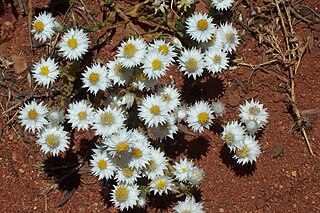
Rhodanthe anthemoides, commonly known as chamomile sunray, is a flowering plant in the family Asteraceae. It is a small, perennial shrub with greyish-green leaves, white papery flowers, yellow centre and is endemic to Australia.

Pimelea spinescens, commonly known as plains rice-flower, spiny rice-flower or prickly pimelea, is a species of flowering plant in the family Thymelaeaceae and is endemic to Victoria. It is a spreading undershrub with elliptic leaves arranged in opposite pairs, and heads of white, cream-coloured or yellow flowers surrounded by 4 elliptic, leaf-like involucral bracts.

Oxylobium arborescens, commonly known as the tall shaggy-pea, is a species of flowering shrub to small tree in the family Fabaceae and is endemic to south-eastern Australia. It has elliptic dark green leaves and yellow pea flowers.

Leucochrysum albicans, commonly known as hoary sunray, is a flowering plant in the family Asteraceae. It is a small perennial with grey leaves, white or yellow flower-heads and is endemic to Australia.

Leionema phylicifolium, commonly known as alpine phebalium, is a shrub that is endemic to south-eastern Australia. It is a small shrub with green, smooth, leathery leaves and pale yellow flowers in spring.

Pimelea serpyllifolia, commonly known as thyme riceflower, is a species of flowering plant in the family Thymelaeaceae and is endemic to southern Australia. It is an erect shrub with narrowly elliptic to spatula-shaped leaves, and compact heads of 4 to 12 yellow, yellowish-green or white flowers surrounded by 2 or 4 leaf-like involucral bracts. Male and female flowers are borne on separate plants.

Leionema diosmeum is a shrub species in the family Rutaceae that is endemic to southern New South Wales, Australia. It has an upright habit, stems with fine soft hairs, variable shaped leaves and yellow flowers from late winter to spring.
Leionema lachnaeoides, is a tall shrub with aromatic leaves and yellow flowers from winter to late spring. It is restricted to the Blue Mountains in New South Wales.

Nematolepis elliptica, is a small, bushy shrub with white flowers in small clusters from September to November. It is endemic to the south coast of New South Wales.

Nematolepis ovatifolia, is a small shrub with rusty coloured scales on the stems, smooth, glossy leaves and white flowers in small clusters in summer. It is endemic to New South Wales.

Rhodanthe floribunda, commonly known as common white sunray, is a flowering, herbaceous plant in the family Asteraceae. It is a small, upright or decumbent plant with white flowers, yellow florets and is endemic to Australia.

Coronidium rupicola, commonly known as the yellow button, is a flowering plant in the family Asteraceae. It is a small, upright, perennial shrub with yellow flowers borne on a single stem and is endemic to Queensland, Australia.

Podolepis decipiens, commonly known as deceiving copperwire-daisy, is a flowering plant in the family Asteraceae and grows in Victoria, Tasmania and New South Wales. It is an upright, perennial herb with yellow daisy-like flowers on a single stem rising from a sparse rosette.

Coronidium monticola, commonly known as the mountain coronidium, is a flowering plant in the family Asteraceae and grows in open forests in eastern Australia. It has woolly, grey-green leaves and mostly yellow flowers.

Argentipallium obtusifolium, commonly known as blunt everlasting, is a species of flowering plant in the family Asteraceae. It is a small, multi-stemmed perennial with white flowers, dark green leaves and is endemic to Australia.

Rhodanthe chlorocephala commonly known as pink and white everlasting, is a flowering plant in the family Asteraceae. It is a small, tufted plant with blue-green leaves, white, pink or yellow flowers and grows in Western Australia and South Australia.

Rhodanthe humboltiana, commonly known as the golden cluster everlasting, is a flowering annual in the family Asteraceae. It is a small, upright, branching plant with yellow flowers, and is endemic to Western Australia.

Leucochrysum molle, commonly known as hoary sunray, is a flowering plant in the family Asteraceae. It is a small, clumping perennial with grey leaves, yellow flower-heads and is endemic to Australia.

Hyalosperma demissum, commonly known as moss sunray, is a flowering plant in the family Asteraceae. It is a small, annual herb with whitish yellow flowers and is endemic to Australia.

Podolepis hieracioides commonly known as long podolepis, is a flowering plant in the family Asteraceae and grows in New South Wales and Victoria. It is a small perennial with yellow flowers.



















